


 |
 |
|
 |
||
Vol. 12 (2): November 2009 |
||
Short-lived freedom for KP2Though initially showing promising signs of readapting successfully to the wild, orphaned pup KP2’s post-release behaviour subsequently proved an increasing source of concern to NOAA seal managers. The pup, abandoned by his mother on a Kauai beach, underwent a lengthy 7½ month rehabilitation process last year at the Kewalo Research Facility in Honolulu, in collaboration with the Marine Mammal Center [see Freedom at last for KP2, TMG 12 (1): 2009]. He was released in December 2008 in a remote area on the island of Molokai. According to NOAA’s Marine Mammal Response Network Coordinator, David Schofield, for two months after his release, satellite tracking indicated that KP2 was exhibiting normal seal behaviour and an ability to thrive in the wild, exploring the north and west shores of Molokai. After discovering Kaunakakai Wharf in early March, however, the rehabilitated seal began interacting with people on a regular basis, swimming with them, climbing onto their boats and boogie-boards, and even allowing young children to ride him. He quickly became, to quote one newspaper, “Molokai’s biggest celebrity”. 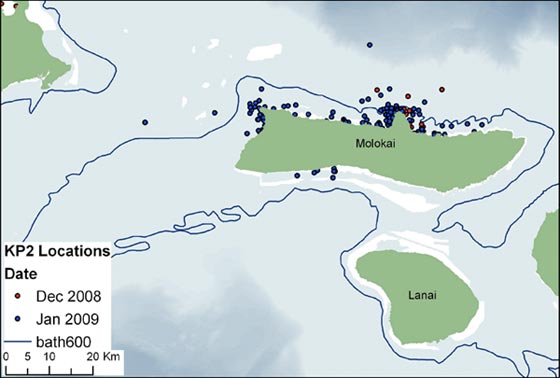 
KP2 satellite tracks. Courtesy: NOAA Fisheries Pacific Islands Region
Human interactions were not only reinforcing such behaviour to the detriment of his readaption to the wild, but – as in the case of Turkish orphaned seal ‘Badem’ – were also posing risks of serious injury to those who insisted on playing and swimming with the seal [see Hawaiian Press Watch, below]. NOAA experts warned that those risks were likely to increase exponentially as the seal grew towards sexual maturity. On several occasions, managers warned that KP2 might even end up accidentally killing a swimmer by holding them underwater during play. "We've had experiences before where a 300-pound animal is just looking to play and then starts holding people underwater for too long,” says Wende Goo, a spokesperson for the National Oceanic and Atmospheric Administration. “And with how much KP2 likes being around people, we think he's bound to get to that point."
NOAA managers first attempted to solve the problem by disturbing the seal just enough that it might leave the Wharf, but to little effect. Then in June 2009, they relocated KP2 to wilder habitat 40 miles away, but within two days he had found his way back – in time, said one newspaper, “to swim with the neighborhood kids before sunset”. As the interactions continued, and concerns over safety intensified, mangers were considering other, more drastic actions. These were said to include a relocation – like R042, another problem seal with a taste for human playmates – to distant Nihoa in the North Western Hawaiian Islands; or even for him to be taken into captivity and put on public display in an aquarium. Such rumblings, however, were causing indignation among locals, who argued that the famous seal should stay exactly where he was. The Wall Street Journal quoted Darrin Abell, owner of the local Paddlers' Inn restaurant, as warning: “If they ship KP2 off the island, it might get ugly here. There'd be an uproar.” “He is one of the toughest challenges in my career,” confessed David Schofield. “People dream of swimming with wild animals, but I can tell you it will end badly both for people and the seal.” In an effort to forestall such an eventuality, KP2 was captured by NOAA staff early on 16 October and airlifted to Oahu. There he was put into temporary confinement at Waikiki Aquarium, to undergo a thorough medical examination before being translocated to a more remote area that would hopefully foster his wild behaviour; the favourite site reportedly being Ka`ula Rock near Niihau. Those hopes, however, were dashed when it was found that an eye ailment that KP2 had been treated for as a pup in rehabilitation had worsened dramatically [see Freedom at last for KP2, TMG 12 (1): 2009]. While the seal had apparently been released with 10-20% vision loss, veterinarians are now reporting that the seal is suffering from cataracts in both eyes, one already having progressed over 80-90% of the lens. In a bleak prognosis, they stated that KP2 is likely to be completely blind within about six months, deeming him “unreleasable”. NOAA scientists have suggested that the disease might be attributable to poor nutrition, the pup having being deprived of vital nutrients contained in mother’s milk, there being no artificial formula that can approximate it. However, similar problems have not been observed in rehabilitation cases involving the Mediterranean monk seal. During KP2’s rehabilitation, which took place at the Kawalo Research Facility in Honolulu, it was theorised that the pup’s early eye problems might have been attributable to environmental factors, including bright reflected sunlight and the artificial seawater used at the facility. The pup’s eye ailments improved substantially after he was moved to a shoreline pen at Marine Corps Base Hawaii in Kaneohe Bay. While KP2 remained in quarantine at Waikiki Aquarium, officials were trying to find a facility that would be able to care for him on permanent basis. In the meantime, Molokai residents, outraged that KP2 had been taken from them, flew to Oahu and staged a demonstration outside the aquarium. Further informationNOAA. 2009. Pacific Islands Region Marine Mammal Response Network Activity Update, Volume 11, January – April 2009: [PDF NOAA. Marine Mammal Response, Pacific Islands Regional Office, NOAA Fisheries. MonkSealMania.blogspot.com: KP2. Schofield, D., G. Levine, F. Gulland and C. Littnan. 2009. The first rehabilitation and release of an abandoned endangered Hawaiian monk seal (Monachus schauinslandi) pup in the Main Hawaiian islands. Poster presentation, in: Workshop "Research, Management, Conservation, and Policy in Monk Seal Recovery: A Global Perspective", 18th Biennial Conference of the Society for Marine Mammalogy. 10th October 2009, Quebec, Canada. [PDF The Monachus Guardian: News Blog. VideoYoutube. KP2: the friendly seal. MoxNews.com. Youtube. Mac and KP2.
|
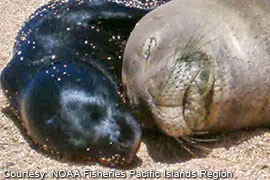 |
|
|
RK06 with one of her pups. |
NOAA Fisheries Pacific Islands Regional Office (PIRO) staff were responsible for veterinary pathology in the case. In a subsequent statement, PIRO declared that the “necropsy revealed the seal [code-named RK06] was carrying a near term, male monk seal pup. This female has had five pups in the past and was pregnant with her sixth. This female was an important breeding female and a huge loss for the main Hawaiian Islands monk seal population.”
Additional details gleaned from court records indicate that Vidinha shot four rounds at the seal using a Browning 22-calibre rifle.
Federal prosecutors characterized Vidinha as being essentially destitute and living out of a car, making imposition of a fine or restitution inappropriate to his circumstances. Although the sentence received condemnation for its perceived leniency, prosecutors agreed to the 90 day sentence because they could not prove that Vidinha intentionally killed the monk seal. Vidinha had claimed that he was trying to scare the animal away from the beach, with two out of the four shots fired striking the seal.
Had the accused refused the plea bargain, and the case gone to trial, Vidinha would have faced up to one year in prison and a $50,000 dollar fine.
While the act of killing the seal shocked many, to others it was also an unwelcome reflection of underlying hostility towards the species in some quarters.
 |
|
|
A sleeping RK19. |
|
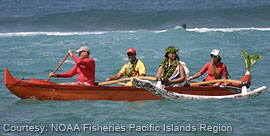 |
|
|
Ceremonial blessing at Poipu. |
The death at Pilaa beach came within a month of another killing on Kauai – that of a five-year old subadult male (RK19); in this case also, the cause of death was found to be bullet wounds.
A traditional Hawaiian ceremony was held on Poipu beach on 18 June in honour of the dead seals, with ashes of one of the animals being scattered from an outrigger canoe, and the ceremonial blessing being conducted by Kauai cultural practitioner Kumu Sabra Kauka.
“The ceremony was held to provide some closure for the local community who have been shocked by these events,” said PIRO, which helped organize the event, “and to give a well-respected Hawaiian cultural practitioner an opportunity to state publicly that such behavior towards Hawaii’s native animals is not acceptable. Kauka was quoted as stating that the monk seals are the ‘Kamaaina’ of the sea and it is all of our responsibility to protect and recover them.”
Admitting that “animosity toward the Hawaiian monk seal at the local community level is high on Kauai, Molokai, and parts of the Big Island,” PIRO is keen to respond through public outreach initiatives, and community liaison with leaders and cultural practitioners. Among the priorities is to “dispel misperceptions about the monk seal, including the belief among some that monk seals are non-native animals and should be treated as “invasive species”.
On 12 June 2009, NOAA Fisheries responded favourably to a petition lodged by three environmental groups that it revise the current critical habitat designation for the monk seal in the Northwestern Hawaiian Islands (NWHI) and designate additional habitat for the species among the Main Hawaiian Islands (MHI).
The three groups, KAHEA, the Center for Biological Diversity and The Ocean Conservancy, had filed their petition in July last year, setting in motion a 12-month review and comment period [Monk seal may gain ‘Critical Habitat’ on main Hawaiian Islands, TMG 11 (2): November 2008]. This culminated in the NMFS finding published in the Federal Register on 12 June 2009, in which the agency announces that it intends to proceed with a revision of critical habitat and provides details on the ongoing revision process.
The revision, the first in 21 years for the Hawaiian monk seal, is likely to significantly expand areas of protection for the species. The NMFS finding lists a range of habitat considered essential to the conservation of the monk seal. These are: (1) sandy beaches preferred by monk seals for pupping and nursing; (2) marine areas less than 20 m depth adjacent to pupping and nursing beaches where young pups learn to forage; (3) marine areas approximately 20 - 200 m depth in the MHI, and approximately 20–500 m depth in the NWHI, preferred by juvenile and adult monk seals for foraging; (4) low levels of unnatural disturbance; and (5) high prey quantity and quality.
In its finding, NMFS indicates that the former atomic test site of Johnston Atoll is also likely to benefit from the rule changes, and provides a brief history of monk seal sightings there over the years, as well as a list of individuals translocated by the agency to Johnston as a result of various management decisions.
NMFS stresses that the proposed rule changes will not affect fishing, surfing, or public beach access, but will restrict federally funded actions that require federal permits, such as federally-permitted fisheries, dredging, military activities or coastal development; these would have to undergo review to ensure they pose no ill-effects to seal or seal habitat.
The next stage in the process, says NMFS, will be publication of a proposed rule describing the revision of monk seal critical habitat, followed by a public comment period and public meetings.
The three organisations who petitioned the government applauded the NMFS decision: “We cannot afford the extinction of a creature so sacred in Hawaiian culture and endemic to these islands,” said Marti Townsend, programme director for KAHEA. “And we cannot expect to save the seals without meaningfully protecting critical habitat.”
NOAA/NMFS. Hawaiian monk seal 12-month finding, Federal Register / Vol.74, No.112 / Friday June 12, 2009 [PDF  75KB].
75KB].
NOAA/NMFS/PIRO. Critical Habitat page.
The August 2009 Research Bulletin of NOAA’s Pacific Islands Fisheries Science Center, reveals that PIFSC scientists established a number of summer field camps in the Northwestern Hawaiian Islands to collect population data on the endangered Hawaiian monk seal.
Camps were set-up at all six major Hawaiian monk seal breeding locations, including French Frigate Shoals (FFS), Laysan Island, Lisianski Island, Pearl and Hermes Reef and Kure Atoll.
According to the Bulletin: “By mid-June, at least 85 monk seal pups had been born in the Northwestern Hawaiian Islands – 16 at FFS, 26 at Laysan, 15 at Lisianski, 11 at Pearl and Hermes, 6 at Midway, and 11 at Kure. In addition, at least 13 pups had been born in the main Hawaiian Islands – 3 on Ni'ihau, 4 on Kauai, 4 on Molokai, and one each on Oahu and Maui. A majority of the pups tagged in 2008 had been sighted as yearlings at Lisianski Island and thus are known to have survived the winter. So far, the proportion of yearlings re-sighted at other sites had been substantially lower, with the potential to increase as the season progresses.”
NOAA. 2009. Field Staff Monitor Monk Seal Population in Northwestern Hawaiian Islands. Quarterly Research Bulletin / August 2009. NOAA Pacific Islands Fisheries Science Center.
Researchers, scientists and managers now have a high-tech tool available for spatially and textually searching an extensive collection of scientific literature on the Northwestern Hawaiian Islands and Papahānaumokuākea Marine National Monument. The PMNM Information Management System Spatial Bibliography combines a mapping tool with a data base of some 3800 scientific articles currently. The mapping tool has 10 kilometre overlays of the entire Northwestern Hawaiian Islands which are referenced by location names.
Kaylene Keller, the Monument’s GIS Specialist and David Graham, Senior Programmer/Program Manager for Data Integration Group led the team that developed the spatial bibliography product. He says researchers, students and managers can, “…search by location and topic to answer permitting questions and to answer management questions. So for example, how many articles do we have related to monk seals in the NWHI for the last 30 years? We can answer that question very easily and managers and scientists can do that themselves through a web application rather than have to get a couple of computer people together to go out and run the query.” Currently one Data Integration Group team member is assigned to inputting and tracking new articles for the spatial bibliography. The Monument’s spatial bibliography is available for public use and can be accessed at http://www.pmnmims.org and more information is available from . – Papahānaumokuākea Marine National Monument.
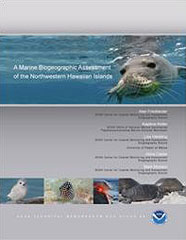 |
|
|
|
|
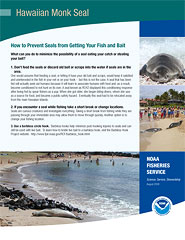 |
|
|
|
Friedlander, A., K. Keller, L. Wedding, A. Clarke, M. Monaco (eds.). 2009. A Marine Biogeographic Assessment of the Northwestern Hawaiian Islands. NOAA Technical Memorandum NOS NCCOS 84. Prepared by NCCOS’s Biogeography Branch in cooperation with the Office of National Marine Sanctuaries Papahanaumokuakea Marine National Monument. Silver Spring, MD.: 1-363. Download Page.
This new NOAA report offers an in-depth look at the marine life and ecosystems of the Northwestern Hawaiian Islands. Chapter 6 includes an assessment of marine protected species in the NWHI, including the Hawaiian monk seal.
The Pacific Islands Regional Office of NOAA Fisheries (NOAA/NMFS/PIRO) has issued a number of updated ‘FAQ’ brochures on the Hawaiian monk seal, aimed at fishermen, beach-goers and the general public. Partly in recognition of hostility towards the conservation of the species in certain sectors of society, the brochures focus on the Main Hawaiian Islands, an area witnessing a gradual increase in seal numbers. We list the brochures below, along with a few brief extracts:
NOAA. 2009. FAQ: Population and location of the Hawaiian monk seal, August 2009. [PDF  359KB]
359KB]
Q: Are there more Hawaiian monk seals in the MHI [Main Hawaiian Islands] today than there were in recent the past?
A: Yes. This is because the population is growing naturally. The number of monk seals that are born in the MHI has increased since the mid-1990s. In 2006 and 2007 there were 12 and 13 pups born, respectively, within the MHI. It is possible that Hawaiian monk seals are beginning to settle back in the MHI, where they once lived a long time ago.[…] There is a misconception that monk seals have been increasing in the MHI because they are being brought over or traveling on their own from the NWHI. No federal agencies or private organizations have transferred monk seals to the MHI since 1995. During that year, 21 male monk seals, and no females, were relocated from the NWHI and released off of the Big Island of Hawaii. Since their release, only six of these seals have been recently observed and reported. Research has also shown that the monk seals rarely migrate from the NWHI to the MHI.
NOAA. 2009. FAQ: Diet of the Hawaiian monk seal, August 2009. [PDF  189KB]
189KB]
Q: Are monk seals eating our fish and decreasing fish stocks?
A: It is unlikely that the small number of seals that live in the main Hawaiian Islands would have a great impact on the local fish populations. There are only around 80-100 seals and each seal eats a variety of prey including squid, octopus, eels, crustaceans, and fish.
NOAA. 2009. FAQ: How to prevent seals from getting your fish and bait, August 2009. [PDF  293KB]
293KB]
One would assume that feeding a seal, or letting it have your old bait and scraps, would keep it satisfied and uninterested in the fish in your net or on your hook - but this is not the case. A seal that has been fed will actually seek out humans because it will learn to associate humans with food and, as a result, become conditioned to not hunt on its own. A seal known as RO42 displayed this conditioning response after being fed by spear fishers as a pup. When she got older, she began biting divers, whom she saw as a source for food, and became a public safety hazard. Eventually this seal had to be relocated away from the main Hawaiian Islands.
NOAA. 2009. Fact Sheet: Top threats to the Hawaiian monk seal in the Main Hawaiian Islands, August 2009.
[PDF  506KB)
506KB)
A small and potentially growing number of monk seals reside and are born in the main Hawaiian Islands (MHI). Fewer than 100 seals have been sighted here. However, despite the small increase of animals in the MHI, the total population across their entire range is in decline. Although more research is needed to fully understand all threats to monk seals it is known that in the Northwestern Hawaiian Islands (NWHI), they face the lack of food, entanglement in marine debris, and shark attacks. More research is needed to understand the impacts in the NWHI. Seals do not appear to lack food in the MHI, yet face additional threats, including: Human Disturbance, Infectious Disease, Fishery Interactions, and Habitat Loss.
NOAA. 2009. Pacific Islands Region Marine Mammal Response Network Activity Update, Volume 11, January – April 2009: [PDF  4.3MB]
4.3MB]
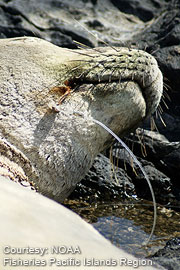 |
|
|
Seal R040, caught on a barbed hook. The seal was later safely dehooked by NOAA staff. |
NOAA also published in summer the most recent issue of the Marine Mammal Response Network Activity Update – a newsletter focusing on marine mammal rescue, monitoring, monk seal pupping around the Main Hawaiian Islands, as well as efforts to limit human-seal interactions.
The January-April 2009 issue carries news of the post release movements of KP2, the orphaned Hawaiian monk seal [see Freedom at last for KP2, TMG 12(1): 2009] that underwent lengthy rehabilitation last year with the assistance of the Marine Mammal Center; the relocation of problem seal RO42 to Nihoa in the North Western Hawaiian Islands; and efforts to capture, treat and dehook a number of seals caught on barbed fishing hooks.
“R042 has provided monk seal managers with a wide array of management challenges,” notes the Update, “from stealing fish, to trying to surf, and even trying to sleep in someone’s tent. After two years of management mitigation, four relocations within the main Hawaiian Islands, and countless media and outreach efforts it was determined that it was in the best interest of public safety and the welfare of the seal that she be relocated to Nihoa. Nihoa is the island at the base of the NWHI chain and is 280 miles (450 km) northwest of Honolulu.”
The decision to relocate came as last resort, according to NOAA: “This is the first time a MHI monk seal has been relocated to the NWHI. While this was likely a successful venture, the action of moving a seal from an environment where it was thriving to a resource poor environment was not the usual management approach, however, it was her only option. RO42’s story teaches us that it will take all of us to keep seals wild. It’s better and safer for humans, the seals, and for the recovery of the population.”
Sealed fate
Molokai residents say a federal agency should not have removed a Hawaiian monk seal without their consent
Molokai residents flew to Oahu to protest a federal agency's removal of a nearly blind Hawaiian monk seal from waters off Kaunakakai.
The residents, who held signs yesterday in front of the Waikiki Aquarium where the seal was taken, said the National Oceanic and Atmospheric Administration removed the seal known as "KP2" without consulting the Molokai community.
They also said the seal should have been treated for cataracts months ago.
"The kids loved that seal," said Molokai resident Karen Holt. "There was no opportunity to say goodbye. Nothing."
Keiko Bonk, the Hawaii program director for the Marine Conservation Biology Institute's monk seal campaign, said there needs to be more communication between the community and NOAA seal recovery officials. […]
[NOAA biologist David] Schofield said the community was informed that the seal would be removed before the end of October.
Schofield said the animal had vision loss of 10 percent to 20 percent when he was released, but seals are able to function in the wild because they also have other sensors.
He said the seal was examined a couple of times this year but it was only after he was brought to Honolulu that officials found the animal had 80 percent vision loss.
He said establishing a sanctuary for KP2 on Molokai would be too expensive at this time and federal officials have been talking to Sea Life Park officials about accepting KP2.
Sealed fate, Honolulu Star Bulletin, 22 October 2009.
Tons of fishing debris hauled in
Trash cleaned from remote reefs to be burned for energy
PEARL HARBOR — Some 80,000 pounds [36,000 Kg.] of derelict fishing debris that was removed from reefs in the Northwestern Hawaiian Islands during a monthlong collection expedition will be turned into electric power.
A crew from the National Oceanic and Atmospheric Administration ship Oscar Elton Sette unloaded the massive pile of nets, ropes and floats yesterday, claiming one of the biggest hauls collected by a single ship since 2005. […]
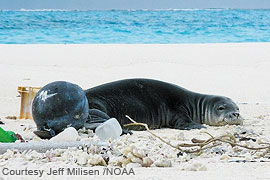 |
|
|
Trash that washed up on shore clutters a seal's resting spot. The Northwestern Hawaiian Islands are right in the path of the ocean's trash flow. |
Weather and the rotating current in the Pacific send a constant stream of debris to the Hawaiian Islands, said Ray Boland, research biologist and dive supervisor. Debris collects in the North Pacific Gyre and is dumped near the Hawai'i archipelago as it passes by.
"The way our currents run in the ocean and the way our atolls are set up, Hawai'i is a perfect spot for debris collection," said Boland, whose realization of the problem in 1996 initiated the collection program. "We're like a gigantic comb filter for the ocean, and as the currents and gyre go it just packs up on us."
Boland said he discovered the problem while working with Hawaiian monk seals, which were increasingly getting entangled in free-floating fish nets in the area. He and three other divers went on a seven-day trip and retrieved 1,000 pounds of derelict fishing gear. […]
Tons of fishing debris hauled in, Honolulu Advertiser, 2 October, 2009
Outrage at lenient sentence
[Convicted seal killer Charles] Vidinha’s 90 day sentence and $25 “special assessment” has outraged many on Kaua`i for its leniency as evidenced by comments on news stories in local and Honolulu newspapers.
Many think Vidinha’s reported excuse – that “he intended to scare the seal away from the beach, not to kill it” according to his attorney federal public defender Alexander Silvert – is silly and are even more outraged that it was offered considering that monk seals can be spooked back into the ocean just by walking up to one.
Seal killer worked for Pflueger; job gave access to crime scene. Got Windmills? October 2, 2009
Kauai man sent to jail for killing endangered monk seal
[…] In Federal Court today, 78-year old Charles Vidinha admitted to killing the pregnant monk seal, but said it was an accident.
"Essentially he was simply down on the beach setting up a camp for Memorial Day weekend for people who were coming over from Oahu, and was setting up fish traps and fish nets and he was simply trying to scare the seal off the beach. He had his rifle, which he uses for pig hunting, and was trying to shoot from his hip from 75 feet away to scare the seal back into the water and didn't even know he hit it," said Alexander Silvert, First Asst. Federal Defender.
According to court documents, Vidinha fired four 0.22-caliber rounds at the seal.
Two of the bullets hit and killed her. […]
Kauai man sent to jail for killing endangered monk seal, KHON2, 25 September 2009.
This baby seal Is a people person
Hawaii’s KP2 made his name loving humans, but his ardor is getting growing pup deported
KAUNAKAKAI, Hawaii — For months now, a baby monk seal named KP2 has been the biggest celebrity on the island of Molokai.
Since the animal arrived at Kaunakakai Wharf in February, several children from the island have made a habit of swimming with him. Area paddlers and boogie boarders have shared laughs watching him climb into or onto their boats and boards. One resident was so comfortable with KP2 that he put his golden retriever in the water with the seal and documented it in a YouTube video. [...]
But now that KP2 calls Molokai home, he is likely to be sent away any day now. That’s because the 17-month-old pup is maturing. His weight, now 175 pounds, has more than doubled since spring, and he has begun playfully grabbing swimmers from behind with his flippers.
Seal experts worry that KP2 risks loving people to death. “We’ve had experiences before where a 300-pound animal is just looking to play and then starts holding people underwater for too long. And with how much KP2 likes being around people, we think he’s bound to get to that point,” says Wende Goo, a spokesperson for the National Oceanic and Atmospheric Administration. [...]
When NOAA first realized KP2 was playing with people at the wharf, the agency moved him 40 miles away. But just two days later, KP2 was at the wharf again.
To some residents, that meant he belonged in Molokai. "If they take him away one more time and he comes back, I don't think this community will let NOAA take him again," says Walter Ritte, executive director of the Hawaiian Learning Center, a nonprofit outfit that teaches local children about Hawaii's ecology.
This Baby Seal Is a People Person, And That Makes Him Dangerous, Wall Street Journal, 15 September, 2009
Slain monk seals remembered
PO’IPU, Kaua’i — Holding a strand of limu kala, a seaweed signifying forgiveness, Sabra Kauka asked people at a ceremony yesterday for two slain Hawaiian monk seals to educate others about the endangered animals.
“They are the kama’aina to the kai,” Kauka said. “They come to land to rest, but the rest of the time their lives are in the sea. This is their home,” the teacher and kumu hula said as the ocean sparkled behind her at Po’ipu Beach Park.
About 100 people gathered to mourn the killings of two monk seals on Kaua’i in the past two months. Kauka took the ashes of the animals into the ocean on a canoe to close the event. [...]
The teenage female RK-06, found dead at Pila'a on May 21, was popularly known as Miloli'i Mom, Olry said.
She was the "devoted mother" of five pups and was pregnant with a sixth when shot, Olry said.
NOAA Fisheries Service law enforcement officers are investigating both deaths as violations of the federal Endangered Species Act. Depending on circumstances, a conviction could lead to fines of $50,000 or more and up to a year in jail.
The two deliberate seal killings are believed to be the first in Hawai'i since the 1980s.
Slain monk seals remembered, Honolulu Advertiser, 19 June, 2009
Monk seal reward nearly quadruples
LIHU‘E — An outpouring of compassion from the community regarding the recent slayings of two monk seals has driven the reward offered for information leading to arrests and convictions from $3,000 to nearly $11,000 in the past week.
“I’ve been tremendously surprised and grateful by the response,” said Steve Benjamin, membership coordinator and Web site administrator for Surfrider Foundation Kaua‘i — the nonprofit organization offering the hefty sum.
News of the slayings spread quickly, and individuals from as far as Texas, Maryland and Michigan sent donations to drive up the monetary reward in hopes that someone will provide information pertaining to the deaths.
In fact, non-residents have consisted of 25 to 30 percent of the funds which have been received, according to Benjamin.
“We hope this will provide enough incentive and give people an indication of how serious, not just Hawai‘i, but the whole world feels about the preservation of the monk seal,” Benjamin said. […]
Monk seal reward nearly quadruples, The Garden Island 14 June 2009.
The Too-Friendly Seal
Life is good for KP2, a young male Hawaiian monk seal who calls Kaunakakai Wharf his home. Wherever people are, KP2 is sure to be found, whether it’s diving with laughing children or grabbing onto an outrigger for a ride. Some find his behavior annoying, but most are endeared by this bright-eyed, playful creature who prefers human company to hanging out with fellow seals. [...]
The [NOAA] team also tried repeatedly to discourage the seal from making the area his home, but with no luck. Finally, on Friday, June 12, NOAA transported him back to Kalaupapa hoping he would socialize with other young seals and “stay wild.” However, in just two days, KP2 had made his way back to the wharf in time to swim with the neighborhood kids before sunset. [...]
NOAA biologist David Schofield worries that when KP2 reaches sexual maturity, he will become not only larger and bolder, but may become aggressive. Because of this, he continues to ask Molokai residents to keep their distance.
Some are arguing that NOAA created the situation when it rescued the seal. They do not think it is fair they should have to stay out of the water to avoid the seal.
But many have also come to love the seal or appreciate the education he has afforded the children and community.
“These kids never would have been ever been able to know a monk seal otherwise,” said one monk seal volunteer.
“I think interacting with the seal is good for people,” said wharf resident Robert Wilt, known as Stretch. He suggests NOAA use KP2 as a “poster boy” – a mascot for the effort to protect Hawaiian monk seals. […]
The Too-Friendly Seal, The Molokai Dispatch, 30 June, 2009
Feds investigate death of monk seal on Kauai
Witnesses report hearing apparent gunshots, seeing mammal wash up on shore
Federal authorities are investigating the death of an endangered Hawaiian monk seal that witnesses said they believed was shot as it lounged on a beach on the North Shore of Kaua’i yesterday.
The National Oceanic & Atmospheric Administration’s Fisheries Service confirmed last night that it retrieved the carcass of a monk seal yesterday. But spokeswoman Wende Goo said the cause of death won’t be determined until a necropsy is performed.
Goo said the dead seal was a female, but declined further comment.
This is the second monk seal found dead on a Kaua’i beach in the past month. On April 19, a 4-year-old male seal was discovered dead, and Goo said that case remains under investigation. [...]
Feds investigate death of monk seal on Kauai, The Honolulu Advertiser, May 22, 2009
~ Additional News Watch items are carried on our TMG Wordpress blog ~
EndQuoteBaby Seals: The Silent Killer The Wall Street Journal picked up the story of the adolescent seal that seems to prefer human company to that of other seals, running it on their front page last week. Their headline? “This Baby Seal Is a People Person, And That Makes Him Dangerous.” Since when are seals considered people? Sure, some might say KP2 comes close, but the headline makes KP2 sound more like a psycho-killer than a playful, young animal. The story goes on to highlight reports that KP2 has held swimmers under the water, and says “KP2 risks loving people to death.” “This Baby Seal Is a People Person” also notes that actor William Shatner was “assaulted” by a similar seal, known as RO42. It’s no wonder Gawker.com, a parody news website based in New York City, had fun with the story. Their headline humorously reads, “Baby Seals: The Silent Killer.” The story cuts right to the point: “The innocent civilians of the Hawaiian islands are being stalked by a bloodthirsty baby seal, which circles a lagoon plotting how to kill humans twice: First, with cuteness; then, with drowning.”
“I got up at 5 am and left to go to the aquarium with my firend [sic] Jen. While there, she had to drain the pool, clean the pool, fill the pool and then we had to feed KP2- the seal- He has now progressed to eating dead fish- previously we had to only feed him live fish, which he tried to catche [sic] and then kill.. the dead fish is an improvement, as while he is in captivity the trainers will be feeding him dead fish- so we were glad to see him swtich [sic] over. It was fun to spend 6 hours with a seal, he is so engaging. At one point we had to give him a little board to play with and he loved it.”
|
Copyright © 2009 The Monachus Guardian. All Rights Reserved |